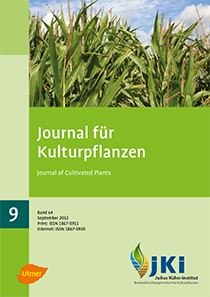A new method for efficacy testing of control measures against adult Western Corn Rootworm in maize
Keywords:
Sampling method, relative, absolute, direct, indirect, mortality, insecticide efficacy, DiabroticaAbstract
Relative sampling methods, like sticky traps, are commonly used to monitor population fluctuations of flying insects, either to facilitate control decisions in integrated pest management or for evaluation of experimental insecticide treatments in efficacy testing, which is necessary before any authorisation of pesticides in Europe. Concerning the latter, however, trap results do not measure the direct effect of a treatment on a pest population. Rather, they show the activity of alive insects after treatment, which is influenced by the control measure together with many other factors.
In the present study, we describe a field method to directly assess the mortality of adult western corn rootworms (Diabrotica virgifera virgifera LeConte) after treatment of maize fields with an insecticide. Fields with continuous maize and heavy D. v. virgifera infestation were treated with a neonicotinoid insecticide and compared to untreated control fields. Efficacy of the treatment was assessed with yellow sticky traps and with a newly developed method for mortality assessment. The latter consisted of cotton panels mounted between the stems of maize plants, in order to collect dead beetles dropping from the plants beyond the covered area.
After insecticide application, the number of dead beetles collected with these panels in the treated plots was significantly higher than those in the control plots only 1 day and 3 days after application. No significant differences were found 7, 14 and 21 days after application. At the same time and in the same fields, the number of beetles caught with yellow sticky traps dropped significantly after insecticide application. Differences between treated plots and control plots were significant 1, 3 and also 7 days after treatment. Results of yellow sticky traps therefore suggested longer persistence of the insecticide than proved by the direct mortality assessment with panels.
DOI: 10.5073/JfK.2012.09.02, https://doi.org/10.5073/JfK.2012.09.02








